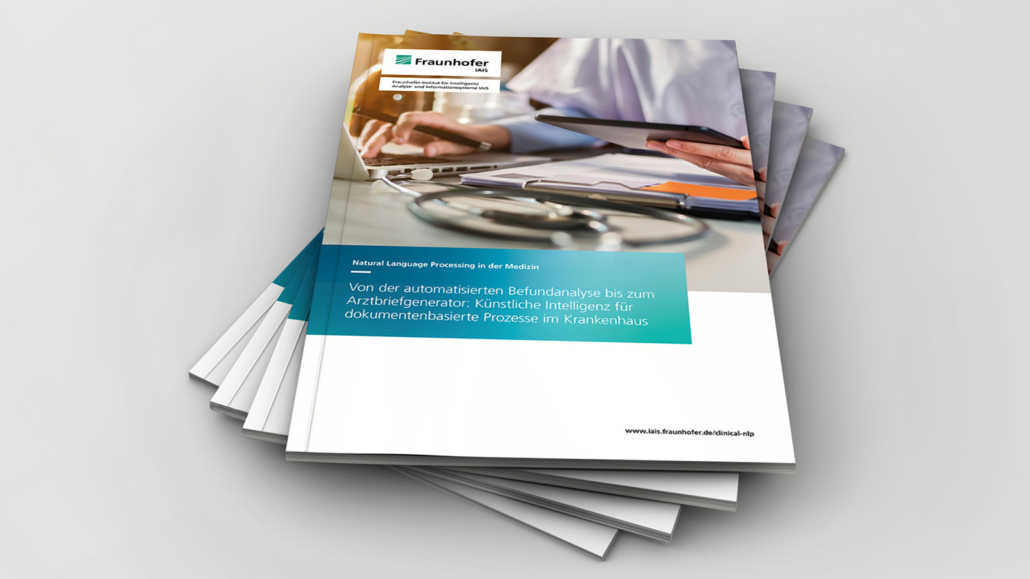Artificial intelligence will soon be able to write doctor’s letters
Around 150 million doctor’s letters are written every year in Germany alone. This takes precious time which could be used elsewhere. The “doctor’s letter generator”, which is currently being developed by scientists from the Fraunhofer Institute for Intelligent Analysis and Information Systems IAIS, could provide a solution for creating the document in a fraction of the time. The application is based on a combination of algorithms and artificial intelligence that is applied for Natural Language Processing (NLP). The new white paper “Natural Language Processing in the Medical Sector” lists the numerous additional opportunities for hospitals when they use NLP.
Around 150 million doctor’s letters are written every year in Germany alone. This takes precious time which could be used elsewhere. The “doctor’s letter generator”, which is currently being developed by scientists from the Fraunhofer Institute for Intelligent Analysis and Information Systems IAIS, could provide a solution for creating the document in a fraction of the time. The application is based on a combination of algorithms and artificial intelligence that is applied for Natural Language Processing (NLP). The new white paper “Natural Language Processing in the Medical Sector” lists the numerous additional opportunities for hospitals when they use NLP.
Health data is currently one of the fastest growing data sets. “How we process this data and what possibilities it offers for patients, care professionals and doctors is an exciting question – and one to which we have at least part of the answer,” explains Dario Antweiler, Healthcare Analytics team leader at Fraunhofer IAIS. Together with his team, he has authored a white paper illuminating the current developments and opportunities for document-based processes in the medical field
https://www.iais.fraunhofer.de/de/geschaeftsfelder/healthcare-analytics/download-clinical-nlp-whitepaper.html .
Additional opportunities from using Large Language Models
In the paper, the experts discuss Large Language Models (LLM), which have undergone drastic development in recent months, catapulting them into the public spotlight. The best-known example of an LLM currently is ChatGPT, a chatbot which creates natural- sounding texts. “In the not-too-distant future, these models will be able to work multi–modally, meaning that they’ll be able to process images and tabular data as well as the texts and spoken language with which they already work,” explains Antweiler. This opens up new possibilities in the medical sector, which could free up staff for other tasks and improve the treatment processes for patients – while considering data protection at all times.
The healthcare sector faces numerous challenges, such as staff shortages, cost pressures and an “information overload” from the constantly increasing amounts of data. Currently, much of the data in hospitals is still laboriously analyzed by hand. “Evaluating, analyzing and drawing conclusions from the data costs valuable time at various points – a commodity that’s lacking in the stressful day-to-day of hospitals. In the worst cases, key information goes missing, which can make treatments more difficult, lead to expensive re-examinations or incomplete accounting,” Antweiler explains.
Doctor’s letter generator aims for market launch by the end of 2024
To find a solution for these problems in hospitals, the Healthcare Analytics Team at Fraunhofer IAIS is working closely with medical professionals. Together with several university hospitals including Essen University Hospital (Universitätsmedizin Essen), it is currently developing various possibilities for information extraction from documents. The next objective is to bring the doctor’s letter generator to the market by the end of 2024, simplifying the creation of discharge letters. To do this, the AI analyzes all existing documents and creates a natural-sounding text which contains easy-to-understand explanations for patients. After a check, making changes or additions if required, the doctors can then send the letter at the click of a button and in a fraction of the time required to create it themselves from scratch. Another advantage is that patients, who often have to wait for some time for this document on the day of their discharge, can leave the hospital more quickly.
Artificial intelligence simplifies processes in hospitals
Other functions of Clinical NLP reduce the workload of medical staff, since the AI automatically collates key information from a patient’s medical records and makes it available to all clinical staff in a clear, structured format. Information is available in next-to-no time and can be thoroughly processed and made wholly accessible to medical staff.
Antweiler says: “In most hospitals, countless texts are evaluated manually every day. This is repeated in various departments and again after discharge by the family physician or specialist. Our applications make these processes fully automated, quick and precise, and – as regards data protection – secure, too. Healthcare systems, and especially staff and patients, would benefit from this.”
The new white paper “Natural Language Processing in the Medical Sector” can be downloaded for free from the Fraunhofer IAIS website.
https://www.iais.fraunhofer.de/de/geschaeftsfelder/healthcare-analytics/download-clinical-nlp-whitepaper.html
© Fraunhofer IAIS/thicha – stock.adobe.com



